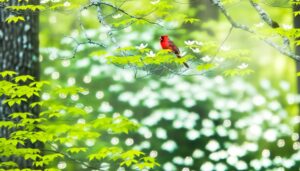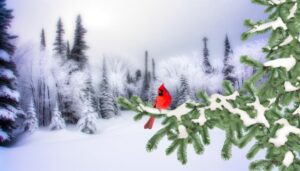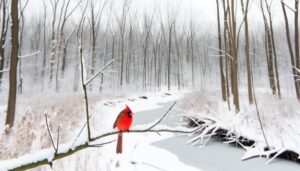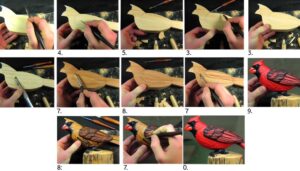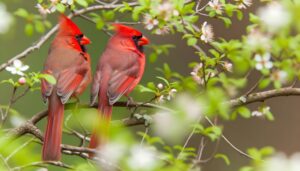Attract Northern Cardinals: Step-by-Step Guide
To attract Northern Cardinals, install sturdy feeders with ample perching space and offer black-oil sunflower seeds and safflower seeds. Plant native shrubs like dogwood and Eastern red cedar for shelter and nesting.
Maintain fresh water sources with bird-friendly features, cleaned regularly. Use native plants with dense foliage to create safe nesting sites.
Reduce predator threats by pruning climbing access and maintaining a clean feeding area. Decoy cardinals with realistic plumage can simulate a safe environment, enhancing attraction.
Strategic placement of decoys near food sources can further entice these vibrant birds. There's a wealth of techniques to boost your cardinal encounters.
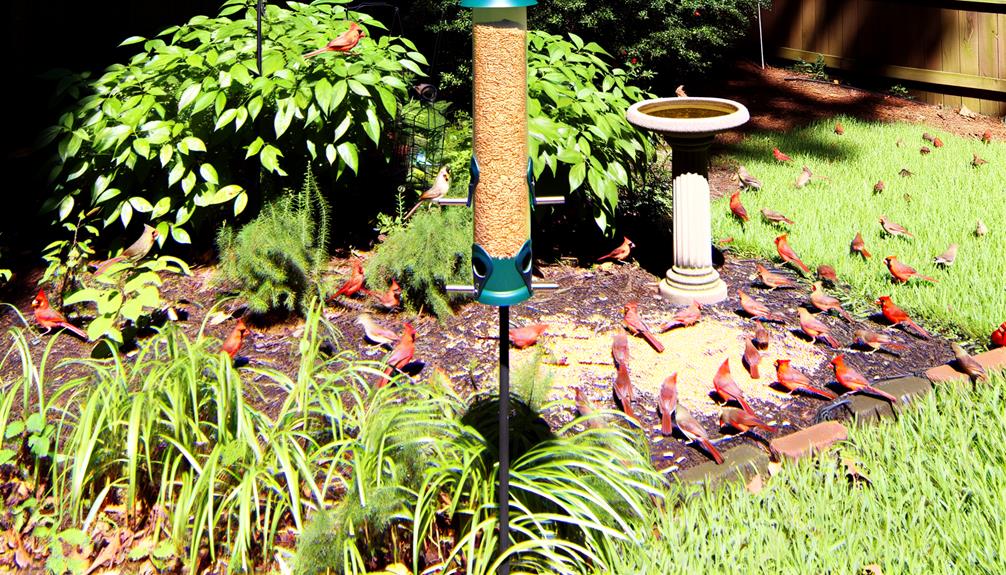
Key Takeaways
- Provide sturdy feeders with ample perching space and roofs for protection.
- Offer black-oil sunflower seeds, safflower seeds, and cracked corn.
- Plant native shrubs and trees like dogwood and Eastern red cedar for shelter.
- Maintain clean, bird-friendly water sources with drippers or misters.
- Limit predator access by pruning and using motion-activated lights or sprinklers.
Provide Suitable Feeders
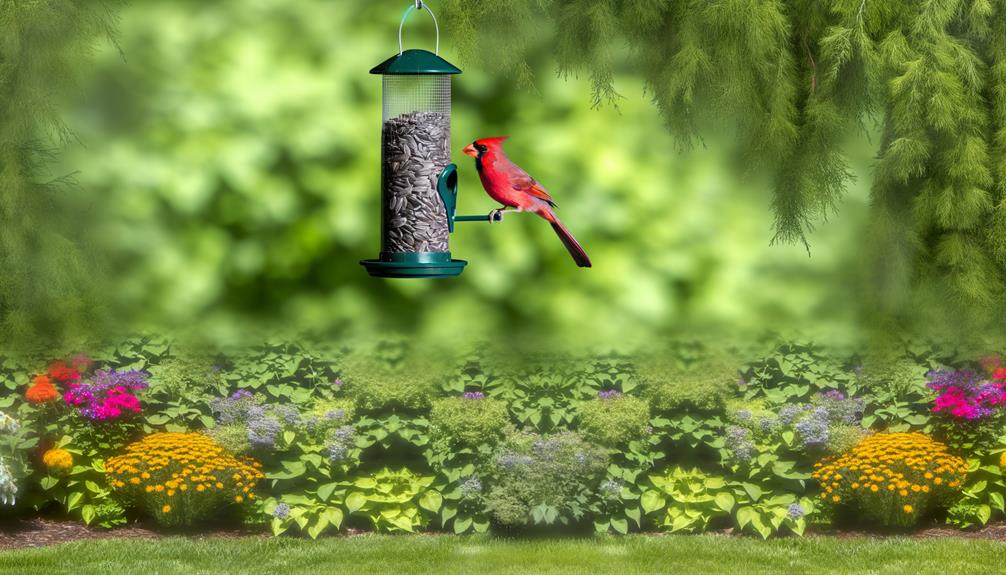
To attract Northern Cardinals, one must provide sturdy, well-built feeders with ample perching space to accommodate their size and feeding habits. These birds exhibit a preference for feeders that offer stability and sufficient room for their relatively large bodies and robust beaks.
Feeders constructed from durable materials such as metal or high-quality plastic guarantee longevity and resistance to weather conditions. Opt for feeders with multiple perches to prevent territorial disputes and facilitate simultaneous feeding.
Additionally, the feeder's design should minimize seed spillage and waste while remaining easy to clean to prevent mold and bacterial growth. A feeder with a roof or cover helps protect the seeds from rain and snow, keeping the food dry and accessible.
Offer Cardinal-Friendly Seeds
Northern Cardinals thrive on a diet rich in specific seeds such as sunflower seeds, safflower seeds, and cracked corn, which cater to their nutritional needs and strong beaks. Sunflower seeds, particularly black-oil sunflower seeds, offer a high-fat content, essential for energy.
Safflower seeds, known for their hard shells, deter less aggressive birds while providing necessary proteins. Cracked corn serves as an additional carbohydrate source, facilitating their overall metabolism.
Observing cardinals, one notices their preference for ground feeding, though platform feeders also suffice. Regularly replenishing these seeds guarantees a consistent food supply.
Additionally, these seeds' high-quality nutrients support their vibrant plumage and reproductive health. Offering cardinal-friendly seeds optimizes their habitat, encouraging their frequent visits.
Plant Native Shrubs and Trees
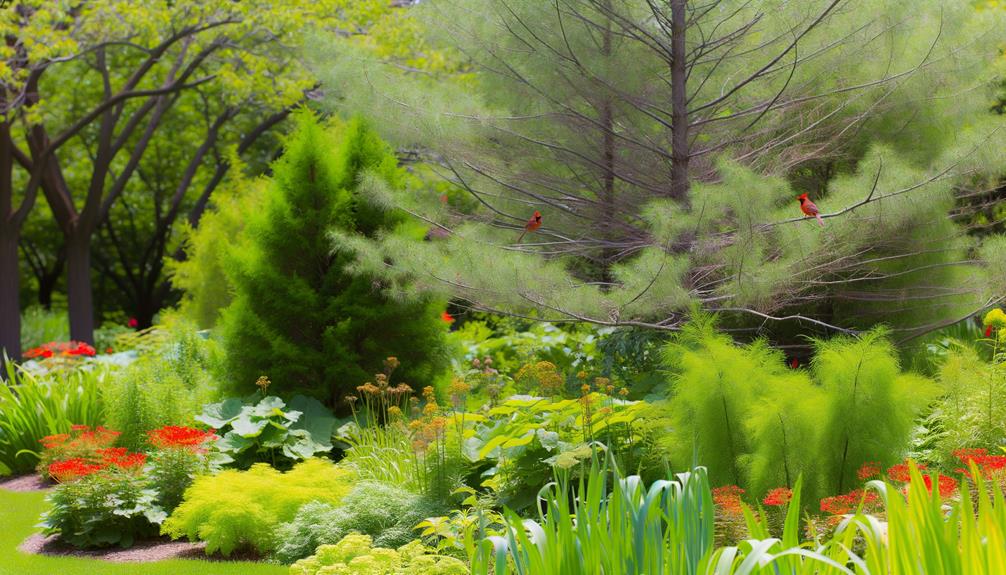
Incorporating native shrubs and trees into the landscape creates significant shelter and nesting habitats for Northern Cardinals, enhancing their chances of survival and reproductive success.
Species such as dogwood (Cornus spp.), Eastern red cedar (Juniperus virginiana), and serviceberry (Amelanchier spp.) provide dense foliage and ample cover. These plants offer protection from predators and harsh weather conditions.
Additionally, native shrubs and trees frequently produce berries and seeds, which form an important part of the cardinals' diet. By planting a variety of these species, one can create a biodiverse environment that supports not only cardinals but also other wildlife.
Observing the ecological preferences of Northern Cardinals and mimicking their natural habitat fosters a thriving avian community in any backyard.
Ensure Fresh Water Sources
Maintaining fresh water sources is essential for attracting Northern Cardinals, as hydration influences their habitat selection.
Bird-friendly water features, such as shallow birdbaths or drippers, provide necessary hydration and bathing opportunities.
Regular water maintenance, including frequent cleaning and replenishment, is important to prevent contamination and maintain consistent water availability.
Bird-Friendly Water Features
A well-maintained bird bath or a small pond with circulating water can greatly attract Northern Cardinals to a garden. The presence of fresh, moving water is vital, as it mimics natural water sources and appeals to the cardinals' sensory preferences.
Bird baths should have a shallow basin, ideally no more than 2 inches deep, to accommodate their drinking and bathing habits. Installing a dripper or mister can enhance the attractiveness by creating gentle ripples and reflections.
A small pond equipped with a recirculating pump ensures consistent water movement, preventing stagnation. Additionally, strategically placing rocks or perches around the water feature provides safe landing spots for the birds.
These elements collectively create an inviting environment for Northern Cardinals, promoting frequent visits.
Regular Water Maintenance
Why is regular water maintenance important for attracting Northern Cardinals and ensuring their health and well-being?
Clean, fresh water is crucial for hydration, preening, and overall health. Stagnant water can harbor harmful bacteria, algae, and parasites, posing significant health risks to cardinals. Regular maintenance, including daily water changes and thorough cleaning of bird baths or water features, prevents contamination.
Observations show cardinals are more likely to frequent well-maintained water sources. Using a water agitator or dripper can enhance water movement, reducing mosquito larvae and attracting cardinals with the sound of flowing water.
Ensuring water sources are shallow and accessible further encourages these birds to visit, promoting their well-being and increasing their presence in one's garden.
Create Safe Nesting Sites
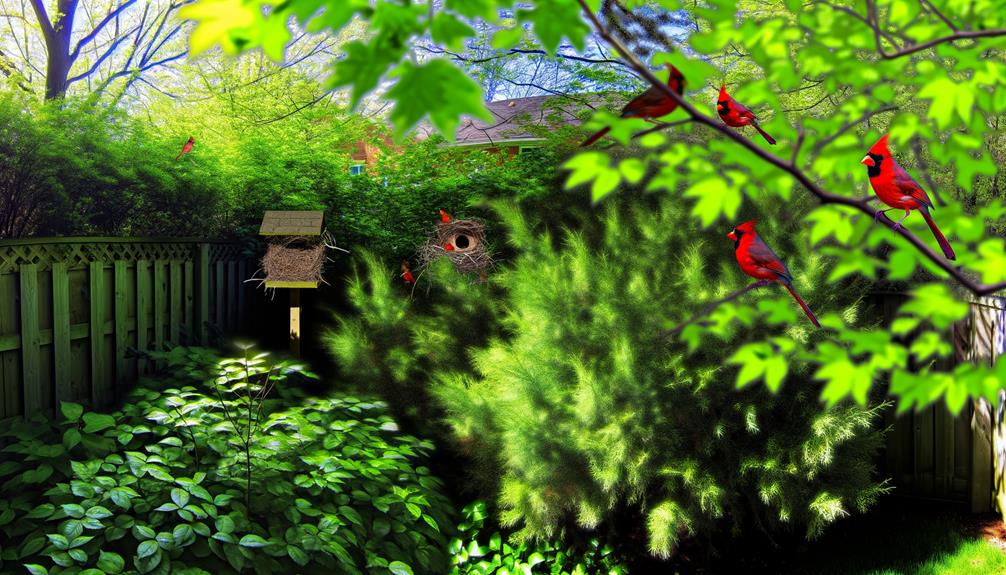
How can one create safe nesting sites for Northern Cardinals, guaranteeing the use of dense shrubbery and thorny plants to provide adequate protection from predators?
Selecting native plants such as junipers, hollies, and dogwoods can offer dense foliage that shields nests from predators. Thorny plants like roses and hawthorns add an extra layer of security.
Placing nesting materials—such as twigs, grasses, and bark—nearby can encourage cardinals to build nests. Position shrubs in a secluded part of the yard, away from high traffic areas, to minimize disturbances.
Make sure the vegetation is layered, with tall trees and low shrubs, creating diverse vertical habitat structures. This approach provides both concealment and accessibility, fostering a safe environment for nesting.
Maintain Clean Feeding Areas
Creating safe nesting sites is essential, but maintaining clean feeding areas is equally important for the health and well-being of Northern Cardinals. Regularly clean bird feeders using a solution of one part bleach to nine parts water to prevent the spread of diseases.
Remove uneaten seeds and hulls to avoid mold growth, which can be harmful to cardinals. Disinfect feeding stations and guarantee they dry completely before refilling. Place feeders in well-drained areas to minimize waste accumulation.
Additionally, rotate feeder locations periodically to reduce pathogen buildup in the soil. By keeping feeding areas clean, one can effectively support the cardinals' immune systems and overall strength, ensuring a thriving population in their habitat.
Add Protective Shelter
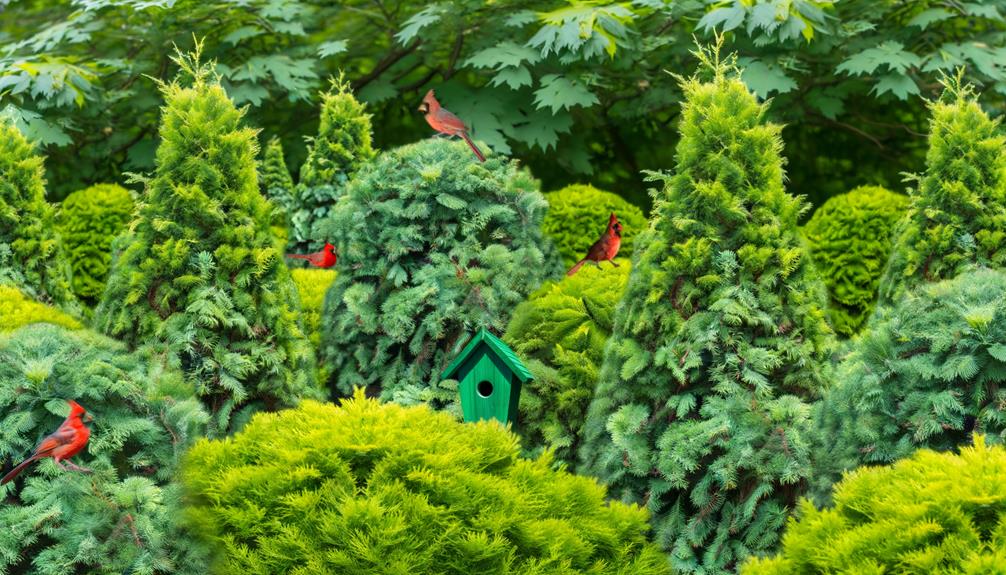
Incorporating dense shrubs, evergreen trees, and thickets into the landscape provides Northern Cardinals with essential protective shelter from predators and harsh weather conditions. These plants offer critical coverage that enables cardinals to nest, roost, and forage safely. Dense foliage creates a microhabitat with moderated temperatures and humidity levels, enhancing survival rates.
| Plant Type | Benefits |
|---|---|
| Dense Shrubs | Concealment from predators |
| Evergreen Trees | Year-round protection |
| Thickets | Nesting and roosting sites |
| Native Plants | Familiar habitat, food sources |
Selecting native plants is particularly advantageous, as these species are well-adapted to the local environment. Cardinals instinctively recognize and use them for both shelter and food. By integrating diverse vegetation layers, one can create a sanctuary that supports Northern Cardinals throughout the year.
Minimize Predator Threats
Ensuring the safety of Northern Cardinals involves implementing strategies to minimize predator threats within their habitat. Installing predator guards on bird feeders and nest boxes can effectively deter common threats like raccoons and squirrels.
In addition, placing feeders at least ten feet away from dense shrubbery reduces ambush opportunities for cats and snakes. Pruning lower branches of trees can also limit access for climbing predators.
Utilizing motion-activated lights or sprinklers can scare away nocturnal predators such as owls. Moreover, maintaining a clean feeding area helps prevent attracting unwanted scavengers.
Use Decoy Cardinals
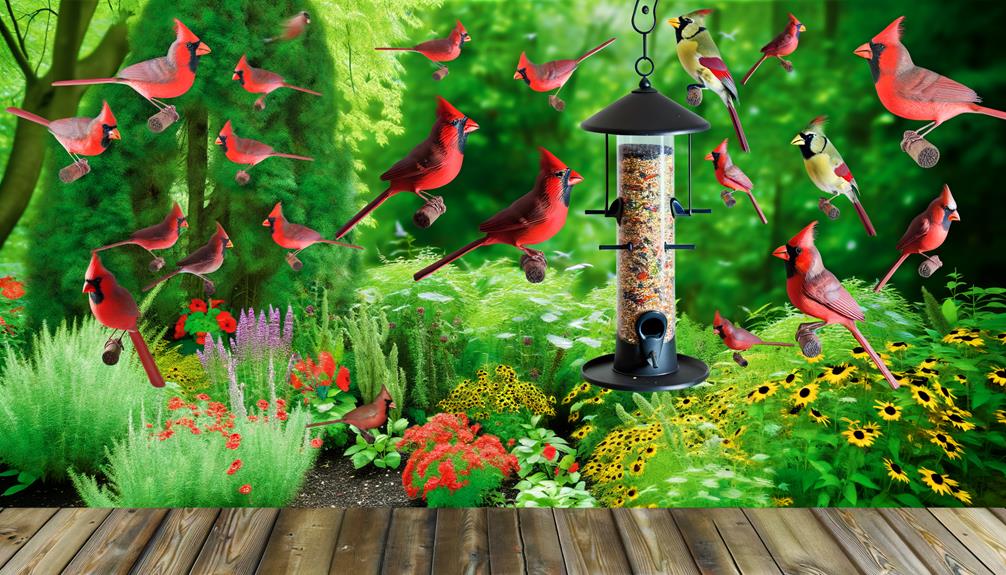
To attract Northern Cardinals, employing decoy cardinals can be highly effective. Realistic cardinal decoys with accurate coloration and size can simulate a safe environment, reducing territorial aggression.
Strategic decoy placement in prominent, visible locations enhances their effectiveness by signaling a desirable habitat.
Realistic Cardinal Appearance
How can one effectively attract Northern Cardinals if not by using very realistic decoy cardinals to imitate their vibrant plumage and behavioral patterns? Replicating the cardinal's striking red feathers and distinctive crest is essential.
Decoys must exhibit accurate coloration, with males showcasing vivid red and females displaying subtle tans and reds. Additionally, behavioral mimicry, such as appropriate posture and subtle movements, enhances the decoy's effectiveness. High-quality materials and UV-resistant paints preserve the decoy's appearance against weathering.
Cardinals are territorial; thus, decoys should convey a natural, non-threatening presence to encourage real cardinals to approach. Observational studies confirm that lifelike decoys significantly increase the likelihood of drawing these birds into one's garden, providing best viewing opportunities.
Strategic Decoy Placement
Best placement of decoy cardinals significantly influences their effectiveness in attracting Northern Cardinals to a specific area. Positioning decoys in open, visible locations increases their visibility to passing cardinals. Placing them near food sources such as feeders and water supplies will make them more attractive. It's pivotal to mount decoys at natural perching heights, mimicking real bird behavior. Decoy orientation should also be considered; facing decoys towards the prevailing wind direction can simulate natural landing patterns.
| Placement Aspect | Recommendation |
|---|---|
| Visibility | Open, visible locations |
| Proximity to Resources | Near feeders and water supplies |
| Mounting Height | Natural perching heights |
| Orientation | Facing prevailing wind direction |
Strategically placing decoys helps create a convincing environment, boosting the likelihood of attracting Northern Cardinals.
Conclusion
By creating an inviting habitat, one can transform their backyard into a haven for northern cardinals. When feeders brim with high-quality seeds and native plants flourish, these vibrant birds will flock like crimson jewels against a lush green backdrop.
Ensuring fresh water sources and clean feeding areas, alongside safe nesting sites, will make cardinals feel at home. With a keen eye on predator threats and added protective shelters, your garden will soon echo with their distinctive melodies.

